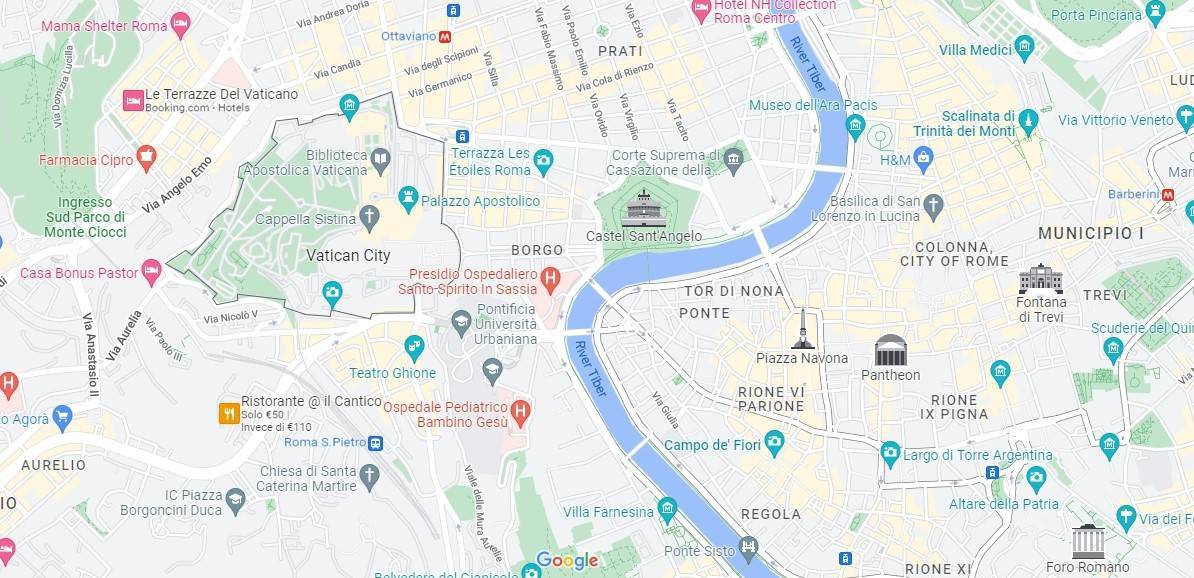This post is a self-guided tour of Vatican City and covers what to see along with descriptions, which attractions require tickets, hours, directions and other information you plan your visit.
As professional tour guides, we're always making stops near Vatican City and offering helpful advice to our guests about visiting.
While some people choose to take tours, some prefer to go on their own and move at their own pace which is why we wrote this post using our guides' first-hand experiences.
At the bottom of this post are some thoughts about Vatican City from both locals and travelers to give you an idea of what your visit will be like.
PLAN YOUR VISIT
Below you will find answers to the most commonly asked questions.
You can also read our in-depth post on Vatican City for other useful information to help you plan for your visit.
Can you enter Vatican City for free?
It is free to enter Vatican City and walk the grounds. You can visit St. Peter's Basilica and Square for free.
However, the Vatican Museums, the Sistine Chapel and the Vatican Gardens require paid tickets. Admission is free on the last Sunday of the month.
TIP: Several money-saving tourist attraction passes include free, skip-the-line entry to the Vatican Museums and St. Peter's Basilica.
How do I get here?
Getting to Vatican City is easy. It is within walking distance of Piazza Navona and Campo de’ Fiori.
Use this Google Map link for directions.

Rome’s public transportation can get you there easily. The closest metro stop is Ottaviano.
And if you are on a Hop-On-Hop-Off tour, most bus routes have a stop at Vatican City.
For more detailed directions, see our post on visiting Vatican City.
When should I visit?
The Vatican Museums are open from Monday to Saturday every day of the year and every last Sunday of the month. (Check for closures here).
It is almost always peak season at the Vatican except for January, February, early December, and late November.
Crowds can be especially large in the summer months.
Most times of the day can be extremely crowded. The busiest times are opening until about 3 pm.
What are the Vatican Museum's hours?
From Monday to Saturday: 8.00 a.m. - 7.00 p.m. with last admission at 5.00 p.m.
Every last Sunday of the month: 9.00 am - 2.00 pm (last admission at 12.30 pm).
What are the must-sees for first-time visitors?
The Vatican Museums, the Sistine Chapel, and St. Peter's Basilica.
Click on the above links to see our detailed posts about each attraction.
Can I get an audio guide?
Yes! Audio guides are available for €6. Find out more here.
Can I take a tour of the Vatican?
Yes! A tour is one of the easiest ways to see Vatican highlights.
Check out some of our favorite Vatican tours.
How do I see the Pope?
Read our detailed post on how to get a glimpse of the Pope.
How long should I plan to stay?
Plan to stay at least four hours in Vatican City, longer during peak seasons.
Can I/should I bring my kids?
Yes! The staff can assist you in finding elevators and child-friendly routes. Please note that there are quite a few nude sculptures.
Is there a dress code?
Yes. Entry to the Vatican Museums, the Sistine Chapel, St. Peter's Basilica and the Vatican Gardens is permitted only to appropriately dressed visitors.
Sleeveless and/or low-cut garments, shorts above the knee, miniskirts and hats are not permitted.
You will be turned away at the entrances if you do not meet the dress code.
Do I pass through security?
There is airport-like security to get into the Basilica. Keep large bags and sharp objects at home when you come to Vatican City.
If you need somewhere to store your bags, take a look at our post on luggage storage in Rome.
Can I eat or drink at the Vatican?
You cannot bring food into the Vatican Museums; there are designated places for eating and drinking on the premises. Alcoholic beverages are not allowed on site.
There are plenty of restaurants in and around Vatican City, so you won't need to travel far to eat.
See our post on Vatican City for dining recommendations.
SELF-GUIDED TOUR OF VATICAN CITY
Vatican City is the world's smallest nation-state. Vatican City spans 106 acres and is surrounded by a two-mile border and it became its sovereign nation in 1929.
Its building began back in the 4th Century, AD. It's situated on a large graveyard and features a maze of secret tunnels.
Below are the main sites to see and you can visit any or all of the below sights in any order.
However, if you are going to the Vatican Museums and the Sistine Chapel which require paid tickets, you may want to plan your self-guided tour around your time there.
Look into tickets for the Vatican Museums and the Sistine Chapel.

St. Peter's Square
Before entering the Vatican Museums, you'll arrive in St. Peter's Square.
This massive square was designed by Gian Lorenzo Bernini in 1656 to allow for the massive weekly papal audience. Pope Alexander VII oversaw the project.
One of the main focal points of the square is a large obelisk that stands 25.5 meters tall. It was designed by an Egyptian pharaoh and originally stood in Heliopolis.
It was moved to Rome by Caligula in 37 AD. It was moved to its current location in 1586.
This is where you can see the Swiss Guard, the Swiss soldiers who protect Vatican City. You can also pick up Papal tickets here. The Papal Apartments can be seen from here.
This area was once used by the Roman emperor, Nero, for chariot races and Christian persecution—including Peter in 65 AD.
It was here that Peter was crucified, and he asked to be crucified upside down because being crucified in the same manner as Jesus felt wrong.
Peter was buried on Vatican Hill—the current site of St. Peter's Basilica dome.
St. Peter's Basilica
Like St. Peter's Square, St. Peter's Basilica was designed by Bramante. It was also designed by Michelangelo, Bernini, and Maderno.
The church was built on the grave of St. Peter, the first Pope and replaced Old St. Peter's Basilica which was built in the 4th Century, AD.
Old St. Peter's, which was in dire need of repair, was demolished in the 1500s to allow for the new church to be built in its place.
Many of the stones from Old St. Peter's were used to build the new basilica. It took over 120 years to build St. Peter's.
Walk into the atrium. The five bronze doors in front of you were the first works of Roman Renaissance art.
They depict several Catholic saints. They are only opened on holy years—every 25 years.
Start to make your way into the nave of the church.
Everything is larger than life in St. Peter's Basilica. It is almost 114 meters wide.
The ornate Baroque interiors were designed as a way to woo churchgoers back to Catholicism during the Counter-Reformation.
To the right is Michelangelo's "Pieta". It depicts Mary holding the body of Jesus.
It sits behind bulletproof glass. He sculpted it in 1499, and it was one of his first major works.
The plaques on the nave floor are etched with the names of famous churches from around the world. They show where the church would end in comparison to St. Peter's.
Continue walking toward the altar. Stop once you are under the dome. This dome was built by Michelangelo.
The dome is one of the largest and most impressive of its kind. It stands almost 450 feet. St. Peter's tomb is nearby, though it is not visible.
You can visit the top of the dome—accessible by elevator or more than 300 stairs.
Sistine Chapel
The Sistine Chapel is one of the most popular sites in Vatican City. This room can get extremely crowded during high seasons.
We strongly recommend taking a guided tour of the Vatican Museums that includes early entry to the Sistine Chapel to avoid crowds.
This chapel is the home to the papal conclaves, the group that chooses the next Pope. The chapel was finished in 1481 and was designed by Baccio Pontelli.
It is named for Pope Sixtus IV, for whom it was named.
The chapel is most famous for the frescoes that adorn the ceilings and walls, painted by Botticelli, Perugino, Ghirlandaio, and of course—Michelangelo.
The frescoes on the walls depict scenes from the life of Moses, scenes from the life of Jesus, narratives from Genesis, and the ancestors of Christ.
The ceiling was painted by Michelangelo from 1508 to 1512. He also painted "The Last Judgment" from 1535 to 1541.
Vatican Museums
The Vatican Museums were founded by Pope Julius II in the early 16th Century.
They are located in Belvedere Palace, the former summer retreat to the Pope. Start your journey in front of the giant pine cone.
Read our in-depth post on the Vatican Museums and how to visit them.
Pine Cone Courtyard
This courtyard is appropriately named Pine Cone Courtyard, thanks to the giant larger-than-life pine cone statue that stands in front of Belvedere Palace.
The courtyard was constructed by Donato Bramante, though the pine cone was constructed much earlier—nearly 2,000 years ago. It originally stood near the Pantheon and represents, Isis, the god of fertility.
Behind you is a giant sphere that was constructed in 1990 by Arnaldo Pomodoro.
Though its meaning is unknown, many speculate that the sphere represents the cosmos.
The two sculptures are very different and represent the old and the new in Vatican City.
Octagonal Courtyard
The next courtyard is called the Octagonal Courtyard. The most impressive piece of art in this courtyard is the Apollo Belvedere.
Apollo was the Greek god of the hunt. Many scholars consider this sculpture to be the most perfect and symmetrical in the world.
It was found during the Renaissance and is thought to have been created around 120 AD. Michelangelo used this sculptor to paint Jesus in "The Last Judgment".
Also in this room are a statue of the River God, Arno; Laocoon, the man who tried to warn the Trojans not to accept the Greek's gift of the wooden horse; and several sarcophagi.
The River God sarcophagus dates back to 140-150 AD. Laocoon was sculpted by Michelangelo.
Hall of Animals
The next room holds "The Belvedere Torso". This is the torso Michelangelo modeled his Jesus's torso after in "The Last Judgment".
The Spiral Staircase
Designed by Giuseppe Momo in 1832, this staircase (also known as the Snail Staircase) is famous due to both its location and size.
This structure is made up of two stairways engraved with iron which form a double helix.
Some visitors may be familiar with this shape as that of DNA, but it’s worth noting that there is no way Momo could have known that when the stairs were constructed.
The Round Room
The next room back is also appropriately named. The mosaic floor is 1700 years old and depicts scenes from battle. The giant bath supposedly once belonged to Nero, emperor of Rome.
It's made of imperial porphyry, a purple stone only found in the mountains of Egypt. The room had to be built around the bath.
Gallery of the Candelabra
The long gallery behind the Round Room is full of pale marble statues. These statues were once colorful, but their paint has long since worn away.
Many of the statues were adorned with fig leaves from the mid-16th Century to the early 19th Century to give the statues a little modesty.
Two of the most prominent statues are of the Greek goddesses Diana and Artemis. Artemis is the goddess of fertility, and Diana is the goddess of the hunt.
Both hunters and farmers used to pray to these statues in hopes of a prosperous year ahead.
Gallery of Tapestries
The next long gallery holds many tapestries that were woven by students of Raphael.
These students would sketch their designs on paper before attempting to fashion large-scale tapestries. All the tapestries depict scenes from Christ's life.
Gallery of Maps
The final long gallery holds 40 maps. These are topographical maps based on Ignazio Dante's drawings from 1580 to 1583.
The ceiling is covered in paintings by Cesare Nebbia and Girolamo Muziano.
Raphael Rooms
To the left are the Raphael Rooms. These rooms include paintings by Raphael and his students.
They are broken down into four rooms: Room of the Segnatura, Room of Heliodorus, Room of the Fire in the Borgo, and Room of Constantine.
Vatican Gardens
To visit the Vatican Gardens, you must purchase a tour ticket. Tours are offered on mini-buses so you can cover more ground easily.
If you plan on going to the Vatican museums, this combined Gardens/Museums ticket might be good for you.
Read more about tours that include the Vatican Gardens.
TIPS FROM LOCALS AND TOURISTS
We thought you might find it helpful to read what others have to say about their trip to Vatican City.
Here is a small sampling of answers to these questions from a Rome travel tips Facebook group from those who have been to the Vatican.
Many people ask if a visit is worth it. For the most part, people said yes.

As for planning ahead, some say to give yourself a full day and that for those who want to move at their own pace, the self-guided audio tour we mentioned above is fine.

Here’s someone who really wanted to make the most of her time. Most people won't need this long!

Here are some great tips when you visit St. Peter’s Basilica. Go early and dress right!

Lastly, many people noted how long the lines are and suggested taking a tour to be able to skip the line.

RELATED POSTS:






